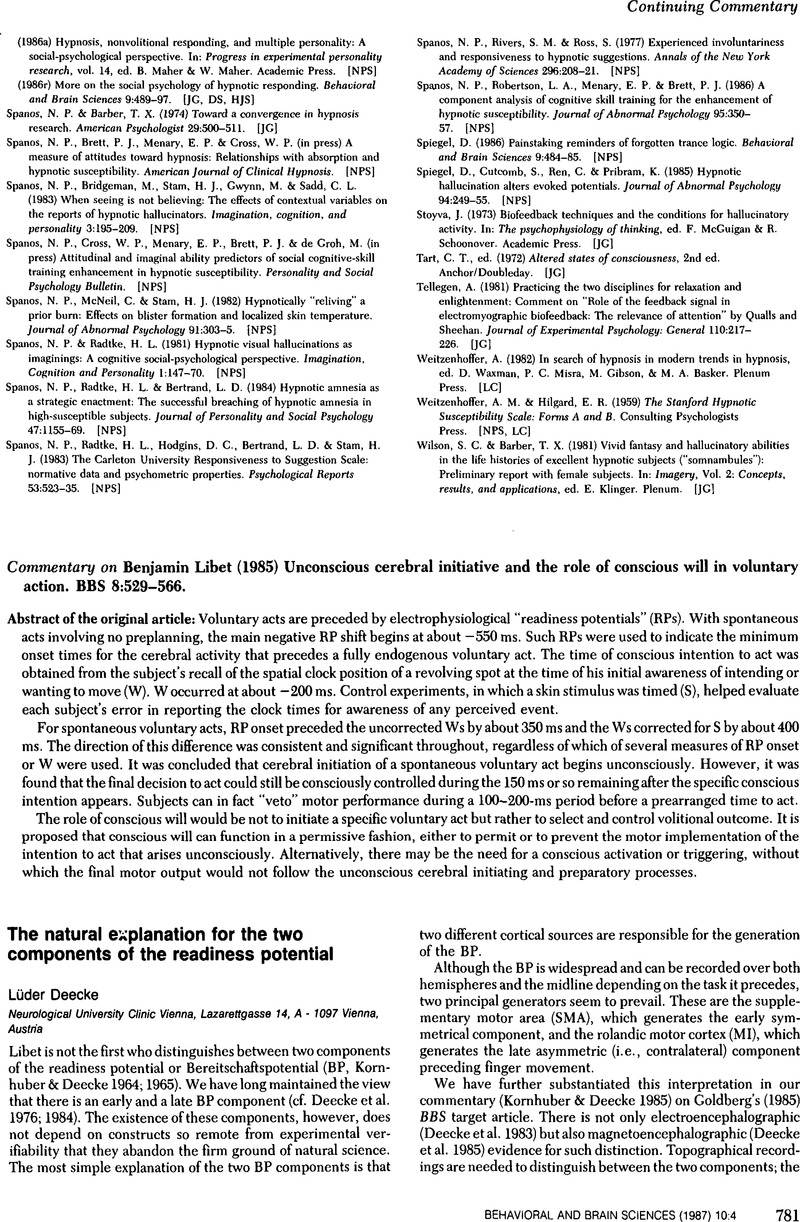Crossref Citations
This article has been cited by the following publications. This list is generated based on data provided by Crossref.
Brown, Jason W
1989.
The nature of voluntary action.
Brain and Cognition,
Vol. 10,
Issue. 1,
p.
105.
Hurley, S. L.
1992.
Some mistakes about consciousness and their motivation.
Behavioral and Brain Sciences,
Vol. 15,
Issue. 2,
p.
211.
Young, Andy
1992.
Closing the Cartesian Theatre.
Behavioral and Brain Sciences,
Vol. 15,
Issue. 2,
p.
233.
Jeannerod, M.
1992.
The where in the brain determines the when in the mind.
Behavioral and Brain Sciences,
Vol. 15,
Issue. 2,
p.
212.
Antony, Michael V.
1992.
The where and when of what?.
Behavioral and Brain Sciences,
Vol. 15,
Issue. 2,
p.
201.
Treisman, Michel
1992.
Does the perception of temporal sequence throw light on consciousness?.
Behavioral and Brain Sciences,
Vol. 15,
Issue. 2,
p.
225.
Rollins, Mark
1992.
Content and conformation: Isomorphism in the neural sway.
Behavioral and Brain Sciences,
Vol. 15,
Issue. 2,
p.
219.
Block, Ned
1992.
Begging the question against phenomenal consciousness.
Behavioral and Brain Sciences,
Vol. 15,
Issue. 2,
p.
205.
Baars, Bernard J.
and
Fehling, Michael
1992.
Consciousness is associated with centralas well asdistributed processes.
Behavioral and Brain Sciences,
Vol. 15,
Issue. 2,
p.
203.
Gregson, Robert A. M.
1992.
Nothing is instantaneous, even in sensation.
Behavioral and Brain Sciences,
Vol. 15,
Issue. 2,
p.
210.
Dennett, Daniel C.
and
Kinsbourne, Marcel
1992.
Escape from the Cartesian Theater.
Behavioral and Brain Sciences,
Vol. 15,
Issue. 2,
p.
234.
Teghtsoonian, Robert
1992.
In defense off the pineal gland.
Behavioral and Brain Sciences,
Vol. 15,
Issue. 2,
p.
224.
Aronson, J.
Dietrich, E.
and
Way, E.
1992.
Throwing the conscious baby out with the Cartesian bath water.
Behavioral and Brain Sciences,
Vol. 15,
Issue. 2,
p.
202.
Dennett, Daniel C.
and
Kinsbourne, Marcel
1992.
Time and the observer: The where and when of consciousness in the brain.
Behavioral and Brain Sciences,
Vol. 15,
Issue. 2,
p.
183.
Velmans, Max
1992.
Is consciousness integrated?.
Behavioral and Brain Sciences,
Vol. 15,
Issue. 2,
p.
229.
Lycan, William G.
1992.
UnCartesian materialism and Lockean introspection.
Behavioral and Brain Sciences,
Vol. 15,
Issue. 2,
p.
216.
Farah, Martha J.
1992.
The distributed pineal gland.
Behavioral and Brain Sciences,
Vol. 15,
Issue. 2,
p.
209.
Rosenthal, David M.
1992.
Time and consciousness.
Behavioral and Brain Sciences,
Vol. 15,
Issue. 2,
p.
220.
Reingold, Eyal M.
1992.
Conscious versus unconscious processes: Are they qualitatively different?.
Behavioral and Brain Sciences,
Vol. 15,
Issue. 2,
p.
218.
McDermott, Drew
1992.
Little “me”.
Behavioral and Brain Sciences,
Vol. 15,
Issue. 2,
p.
217.





